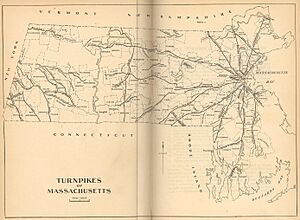Cambridge and Concord Turnpike facts for kids
The Cambridge and Concord Turnpike was an old road in Massachusetts. It was built a long time ago to connect the towns of Cambridge and Concord, Massachusetts. A turnpike is a special kind of road where people pay a fee, called a toll, to use it. Today, parts of this old turnpike are still used as modern roads, like Massachusetts Route 2. Other parts are now important local streets.
Contents
What Was the Turnpike's Route?
The Cambridge and Concord Turnpike started in Cambridge. This was near where the Longfellow Bridge is today. It followed what is now Broadway. The road then met another old turnpike, the Middlesex Turnpike. This is now Hampshire Street.
Journey Through Towns
The turnpike continued past Harvard University. It stayed about 90 feet (27 meters) away from the college. This was a rule at the time. Then it went northwest, passing Fresh Pond. It continued through Belmont Center. After Belmont, the road went to Lincoln. This part is now called Concord Avenue.
The turnpike went in a straight line through Lincoln. It ended in Concord Center. Today, a part of the old turnpike is still Massachusetts Route 2. Another section goes into Concord as Cambridge Turnpike.
How Was the Turnpike Built?
The Cambridge and Concord Turnpike Corporation was created in 1803. The Massachusetts government approved it. Most of the road was built between 1805 and 1806. Builders tried to make it very straight. This caused problems because it went over steep hills. Later, they changed the route a bit to make it easier to use.
Opening for Business
Much of the road opened in February 1807. The part within Cambridge was finished later, around 1812. Two tollgates were put on the turnpike. One was near Fresh Pond. The other was in Lincoln. No tollgates were built in Cambridge itself. This was because of a legal issue.
The road was usually about 50 feet (15 meters) wide. In some places, like Broadway, it was as wide as 100 feet (30 meters).
Why It Wasn't a Success
The turnpike did not make much money. It was not a good business idea. One reason was its very straight path. This meant it had steep hills that were hard for wagons to climb. Also, it did not go through the important town of Lexington. This meant fewer people used it. In May 1829, the turnpike became a free public road.


